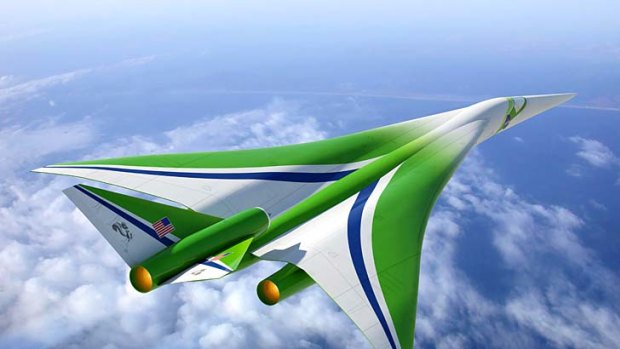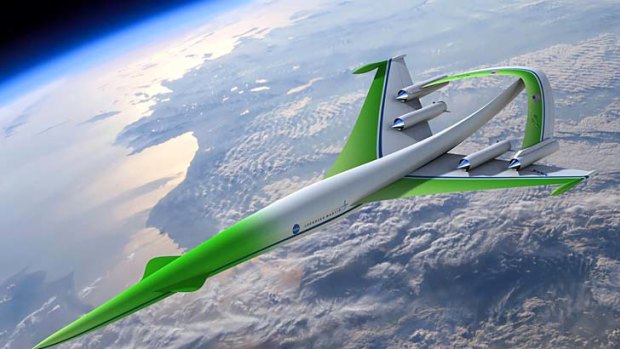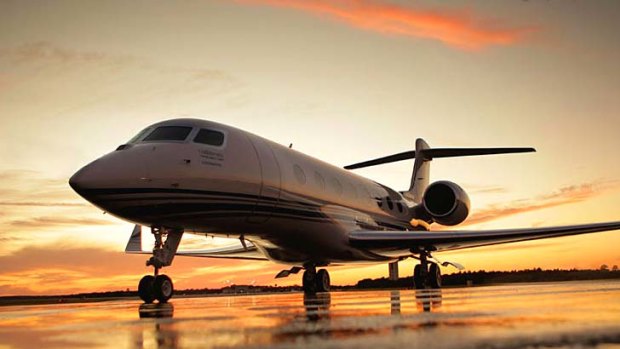This was published 11 years ago
'Son of Concorde': London to Sydney in four hours gets closer
By Clive Dorman

'Son of Concorde' ... our ability to fly at supersonic speeds over land in commercial aircraft depends on the effort to reduce the sonic boom, says NASA.Credit: NASA/Lockheed Martin
They're playing with our minds again ... and they're on a sure-fire winner. Aeronautical designers last week again unleashed their trusty headline-grabber about the imminence of a "Son of Concorde".
London to Sydney in four hours, they were saying, in the run-up to next month's Farnborough air show outside London in the UK, which is one of the aerospace industry's main annual sales jamborees.
Importantly, the boffins were talking about the technical details of breakthroughs in computer-aided design that they reckon can finally overcome the biggest obstacle – Concorde's inability to fly supersonically over land.
I was sucked in despite a knowing warning yesterday from former Sydney Morning Herald aviation editor Ben Sandilands. "Every single story about a Concorde successor ever written has been wrong," he told me bluntly.
But the highly technical report by veteran aviation writer Guy Norris and colleague Graham Warwick in Aviation Week and Space Technology was very specific about the progress that has been made.
"The biggest barriers to development of economically viable and environmentally acceptable supersonic transports — sonic boom and airport noise — may be about to be breached," they wrote. "Through development of design tools allowing aircraft to be shaped to produce quieter booms, and noise-reducing nozzle concepts, NASA and industry are growing confident that routine supersonic overland flight is within reach."

One of Lockheed Martin's designs for a supersonic aircraft that could travel over land with reduced sonic booms.Credit: NASA/Lockheed Martin
The London Sunday Times reported that Boeing, Lockheed Martin and Gulfstream were in a race to build a Concorde successor aimed initially at the business jet market.
Backed by the US space agency NASA, the three companies believe they are close to muffling the sonic boom to create a sound described by a Gulfstream engineer as "closer to a puff or plop".
"The fact that the big boys are all close confirms industry rumours that a new generation of supersonic planes is now, finally, within reach," the engineer told the Sunday Times.

The fastest subsonic executive jet, Gulfstream's forthcoming G650, can fly 11,000 kms at 1041km/h and has a top speed of 1133 km/h.
Lighter composite materials, more advanced engines and smaller fuselages could enable new jets to travel about twice as fast as Concorde, which flew at up to 2187 km/h. That would enable speeds of more than 4000 km/h, allowing scheduled "block" times between Sydney and London, 17,000 kms away, of around five hours.
The fastest subsonic executive jet, Gulfstream's forthcoming G650, can fly 11,000 kms at a mere 1041 km/h and has a top speed of 1133 km/h. But the imagined successor, dubbed the X-54, would "prove that an aircraft can be shaped for low sonic boom", according to Aviation Week's report.
The new design would be "sketched out" at Farnborough along with other supersonic prototypes, air show executives told the Sunday Times.
The sonic boom was the major factor that prevented Concorde from ever being developed beyond an expensive experimental aircraft. By the time an Air France Concorde crashed in 2000 in a disastrous encounter with runway debris after taking off from Paris Charles de Gaulle, the plane was already having to deal with daunting ageing-aircraft issues as most Concordes by then were approaching 30 years old.
In the end, without a commercial successor in sight, Air France and British Airways decided to ground them in 2003.
At that time and to this day, the airline industry is mesmerised by affordability, with the Airbus A380 and the Boeing 787 Dreamliner delivering previously unattainably low unit economics – the cost per seat per kilometre.
The X-54 business jet wouldn't fly until after 2020, which means a full-sized jet seating around 300 people wouldn't be available until around 2030 assuming the new technology was reliable and successful.
Even then, the airline industry struggles to answer the question: what would happen to the existing subsonic jet fleet if those flying business and first class suddenly left to become clients of the sexy new supersonic transport (SST)? Most of the world's long-haul international fleet would be uneconomic without business travellers paying up to seven times the going rate down the back of the plane.
But there's no doubt we'll get there eventually. Australia is among the countries farthest from the world's main human populations in the northern hemisphere and the people for whom the term "tyranny of distance" was coined.
What do you think? Are we likely to be flying at supersonic speeds again within 10 years? Or will these concepts remain in the realm of fantasy?
Note: Last week's blog received an overwhelming response from readers. Unfortunately as a result of the huge volume of comments, some comments slipped through that should not have been published. These have since been removed and we apologise for any offence caused.
Follow the Traveller section on Twitter @FairfaxTravel
Sign up for the Traveller newsletter
The latest travel news, tips and inspiration delivered to your inbox. Sign up now.